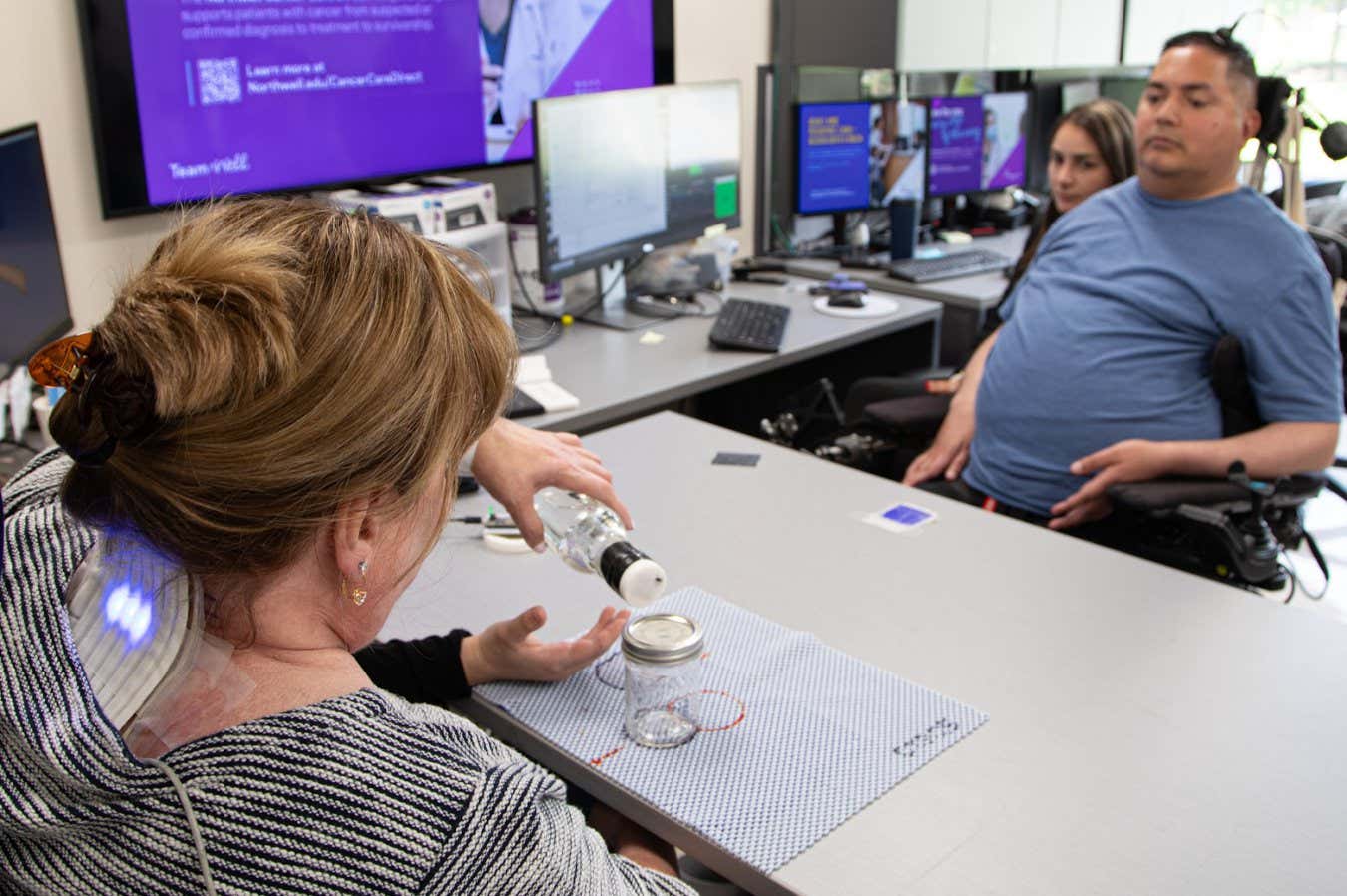
Keith Thomas (right) was able to control another person’s hand
MATTHEW LIBASSI/Feinstein Institutes for Medical research
A man with paralysis has been able to move and sense another person’s hand as if it were his own, thanks to a new kind of “telepathic” brain implant. “We created a mind-body connection between two different individuals,” says Chad Bouton at the Feinstein Institutes for Medical Research in New York state.
The approach could be used as a form of rehabilitation after spinal cord injury, allowing people with paralysis to work together, and may one day even allow people to share experiences remotely, says Bouton.
Bouton and his colleagues worked with Keith Thomas, a man in his 40s who was paralysed from the chest down after a diving accident in July 2020, meaning he lost all sensation and movement in his hands.
In a prior study in 2023, the researchers implanted five sets of tiny electrodes in the parts of Thomas’s brain involved in moving and feeling his right hand, allowing them to read his neural activity via a device fixed to his skull.
By feeding these signals into a computer running an artificial intelligence model, the researchers could decode the neural activity and wirelessly send signals to electrodes placed on the skin of Thomas’s forearm, causing muscles to contract and relax to move his hand. Thomas also wore force sensors on his hand, feeding signals back into his brain implants via the computer to create a sense of touch. As a result, he could use his thoughts to pick up objects and feel them in his hand for the first time in years.
Now, the team has used a similar set-up to allow Thomas to control another person’s hand and feel through it. In one experiment, the researchers got a non-disabled woman to wear the forearm electrodes and a handful of force sensors on one thumb and index finger. While she made no attempt to move, Thomas was able to open and close her hand by imagining moving his own.
He was also able to feel, in his own hand, the sensation of her fingers closing around a baseball, a soft foam ball and a firmer ball – and, while blindfolded, distinguish between them based on their hardness. “It definitely feels strange,” says Thomas. “Eventually, you get used to it.”
Thomas was only able to tell the balls apart with 64 per cent accuracy, but this figure could easily be improved by optimising the number and distribution of sensors worn on the hand, says Bouton. He also wasn’t able to feel the shape of the balls, but using more brain electrodes and force sensors would make this possible for various objects, says Bouton.
In another similar experiment, Thomas was able to help a woman with paralysis called Kathy Denapoli to pick up and drink from a can, something she struggled to do on her own due to having little movement in her fingers. “It actually was pretty amazing, you’re helping somebody by just thinking about it,” says Thomas.
Electrodes implanted into Keith Thomas’ brain are wired to a computer
MATTHEW LIBASSI/Feinstein Institutes for Medical Research
After working with Thomas for a few months, Denapoli’s grip strength has nearly doubled, says Bouton. Because Denapoli’s paralysis is less severe, it is hard to ethically justify her having the invasive surgery herself, and while similar improvements in grip strength can be achieved using standard therapies that electrically stimulate the muscles or spinal cord, Thomas and Denapoli found working together more engaging than rehabilitating on their own, says Bouton.
“There’s benefit from just talking to them, like, ‘How’s your weekend?’, and that makes you feel good about yourself and makes them feel good about themselves too,” says Thomas. The team plans to trial the approach in more people next year, says Bouton.
Rob Tylor, who is paralysed and is a lay member of the scientific committee at the Inspire Foundation, a spinal cord injury charity, sees potential value in the approach for some people with paralysis.
“I think it’s a useful option to have,” he says. “It can be quite fun working with other patients, perhaps with similar experiences. It can very much contribute to someone’s quality of life.” But appropriately pairing people with similar outlooks and motivations will be crucial, he adds.
Bouton acknowledges that many ethical questions surrounding who may benefit from the approach must be ironed out for it to gain approval for wider medical use, which he hopes to achieve within the next decade.
Hypothetically, such technology could even have non-medical uses, such as enabling a non-disabled person to remotely control and feel through someone else, says Bouton. “This could be a new way for humans to connect on a whole other level,” he says.
But that raises far more ethical issues. “Is it good or bad for society for people to be able to control and feel through other people?” says Harith Akram at University College London Hospitals. “You can imagine you could cause harm to another person through their own body, or commit a crime by controlling their body and say, ‘It wasn’t me’.”
Topics:
Source link : https://www.newscientist.com/article/2499936-paralysed-man-can-feel-objects-through-another-persons-hand/?utm_campaign=RSS%7CNSNS&utm_source=NSNS&utm_medium=RSS&utm_content=home
Author :
Publish date : 2025-10-14 16:52:00
Copyright for syndicated content belongs to the linked Source.